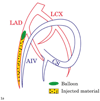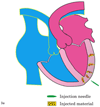Rescuing the failing heart by targeted gene transfer
- PMID: 21371634
- PMCID: PMC3070185
- DOI: 10.1016/j.jacc.2010.11.023
Rescuing the failing heart by targeted gene transfer
Abstract
Congestive heart failure is a major cause of morbidity and mortality in the United States. Although progress in conventional treatments is making steady and incremental gains to decrease heart failure mortality, there is a critical need to explore new therapeutic approaches. Gene therapy was initially applied in the clinical setting for inherited monogenic disorders. It is now apparent that gene therapy has broader potential that also includes acquired polygenic diseases, such as congestive heart failure. Recent advances in understanding of the molecular basis of myocardial dysfunction, together with the evolution of increasingly efficient gene transfer technology, have placed heart failure within the reach of gene-based therapy. Furthermore, the recent successful and safe completion of a phase 2 trial targeting the sarcoplasmic reticulum Ca(2+) ATPase pump along with the start of more recent phase 1 trials are ushering in a new era of gene therapy for the treatment of heart failure.
Copyright © 2011 American College of Cardiology Foundation. Published by Elsevier Inc. All rights reserved.
Figures









References
-
- Felgner PL. Nonviral strategies for gene therapy. Sci Am. 1997;276:102–106. - PubMed
-
- Nabel GJ. The future of gene therapy. Ernst Schering Res Found Workshop. 2003:1–16. - PubMed
-
- Guzman RJ, Lemarchand P, Crystal RG, Epstein SE, Finkel T. Efficient and selective adenovirus-mediated gene transfer into vascular neointima. Circulation. 1993;88:2838–2848. - PubMed
-
- Sambamoorthi U, Akincigil A, McSpiritt E, Crystal S. Zidovudine use during pregnancy among HIV-infected women on Medicaid. J Acquir Immune Defic Syndr. 2002;30:429–439. - PubMed
Publication types
MeSH terms
Substances
Grants and funding
LinkOut - more resources
Full Text Sources
Medical
Miscellaneous

